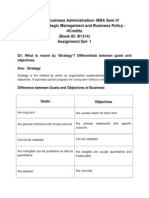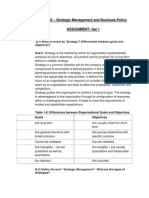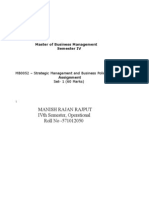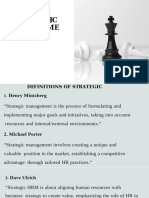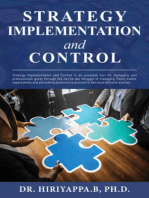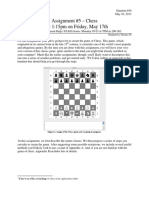MB0052 - Strategic Management and Business Policy - 4credits
MB0052 - Strategic Management and Business Policy - 4credits
Uploaded by
arshadthematrixCopyright:
Available Formats
MB0052 - Strategic Management and Business Policy - 4credits
MB0052 - Strategic Management and Business Policy - 4credits
Uploaded by
arshadthematrixOriginal Title
Copyright
Available Formats
Share this document
Did you find this document useful?
Is this content inappropriate?
Copyright:
Available Formats
MB0052 - Strategic Management and Business Policy - 4credits
MB0052 - Strategic Management and Business Policy - 4credits
Uploaded by
arshadthematrixCopyright:
Available Formats
MB0052 Strategic Management and Business Policy - 4Credits (Book ID: B1314) Assignment Set- 1 (60 Marks) Submitted
d By Shagufta Parveen Siddique
1) What is meant by Strategy? Differentiate between goals and objectives. AnswerA strategy involves integrating organizational activities and assigning the limited resources within its environment to meet the organization goals. Strategy is the method by which an organization systematically achieves its future objectives. A business cannot progress for a long term without a reliable strategy. It defines the general mission and vision of an organization. Strategy guides the organization to achieve a long term goal. The strategy is advantageous to the organization through its configuration of resources within a challenging environment. It helps to meet the requirements of market and stakeholder expectations. Strategy is a plan that is aimed to give a competitive advantage to the organization over rivals through differentiation. Creating a strategy begins with extensive research and analysis. It is a process through which senior management concentrates on top priority issues tackled by the company to be successful in a long term.
Table 1: Differences between Organizational Goals and Objectives Goals Are long term Are general intentions with broad outcome Cannot be validated Are intangible can be qualitative as well as quantitative Are abstract Objectives Are usually meant for short term Are precise statements with specific outcome Can be validated Are tangible are usually quantitative and measurable Are concrete
2) Define the term Strategic Management. What are the types of strategies? AnswerStrategic management is a systematic approach of analyzing, planning and implementing the strategy in an organization to ensure a continued success. Strategic management is a long term procedure which helps the organization in achieving a long term goal and its overall responsibility lies with the general management team. It focuses on building a solid foundation that will be subsequently achieved by the combined efforts of each and every employee of the organization.
Types of Strategies:
1. Corporate level-The board of directors and chief executive officers are involved in developing strategies at corporate level. Corporate level strategies are innovative, pervasive and futuristic in nature. The four grand strategies in a corporate level are: Stability and expansion strategy Retrenchment Corporate restructuring Combination strategies concept of synergy
2. Business level-Business level strategy relates to a unit within an organization. Mainly strategic business unit (SBU) managers are involved in this level. It is the process of formulating the objectives of the organization and allocating the resources among various functional areas. Business level strategy is more specific and action oriented. It mainly relates to how a strategy functions rather than what a strategy is in corporate level. The main aspects of business level strategies are related with: Business stakeholders Achieving cost leadership and differentiation Risk factors
3. Tactical of functional level-The functional strategy mainly includes the strategies related to specific functional area in the organization such as production, marketing, finance and personnel (employees). Decisions at functional level are often described as tactical decisions. Tactical decision means involving or pertaining to actions for short term than those of a larger purpose. Considering tactical decisions in functional level strategy describes involving actions to specific functional area. The aim of the functional strategy is doing things right whereas the corporate and business level strategy stresses on doing the right thing. The different types of strategies at functional level are: Procuring and managing Monitoring and directing resources towards the goal
4. Operational level-Operational level is concerned with successful implementation of strategic decisions made at corporate and business level. The basic function of this level is translating the strategic decisions into strategic actions. The basic aspects in operational level are: Achieving cost and operational efficiency Optimal utilization of resources Productivity
3) Describe Porters five forces Model. AnswerMichael E. Porter developed the Five Force Model in his book, Competitive Strategy. Porter has identified five competitive forces that influence every industry and market. The level of these forces determines the intensity of competition in an industry. The objective of corporate strategy should be to revise these competitive forces in a way that improves the position of the organization. Figure 1: Describes forces driving industry competitions.
Forces driving industry competitions are: Threat of new entrants New entrants to an industry generally bring new capacity; desire to gain market share and substantial resources. Therefore, they are threats to an established organization. The threat of an entry depends on the presence of entry barriers and the reactions can be expected from existing competitors. An entry barrier is a hindrance that makes it difficult for a company to enter an industry. Suppliers Suppliers affect the industry by raising prices or reducing the quality of purchased goods and services. Rivalry among existing firms In most industries, organizations are mutually dependent. A competitive move by one organization may result in a noticeable effect on its competitors and thus cause retaliation or counter efforts. Buyers Buyers affect an industry through their ability to reduce prices, bargain for higher quality or more services.
Threat of substitute products and services Substitute products appear different but satisfy the same needs as the original product. Substitute products curb the potential returns of an industry by placing a ceiling on the prices firms can profitably charge. Other stakeholders - A sixth force should be included to Porters list to include a variety of stakeholder groups. Some of these groups include governments, local communities, trade association unions, and shareholders. The importance of stakeholders varies according to the industry.
4) What is strategic formulation and what are its processes? AnswerStrategy formulation is the development of long term plans. It is used for the effective management of environmental opportunities and for the threats which weaken corporate management. Its objective is to express strategically information to achieve a definite goal. The following are the features of strategy formulation: Defining the corporate mission and goals Specifying achievable objectives Developing strategies Setting company policy guidelines
Steps of strategic decision making process:
1. Creating a constructive environment
6. Communicate your decision and move to action
2. Generating good alternatives
5. Checking and confirming your decision
3. Exploring the chosen alternatives
4. Choosing the best alternative
Table 2: Steps of Strategic Decision Making Process 1) Creating a constructive environment As a strategist, you must do the following to create a constructive environment: i. Establish the objectives Define what you want to achieve. ii. Agree on the process You must focus on the final decision, which is made after establishing the objective. iii. Involve the right people Make sure you have the right team of people. iv. Allow opinions to be heard Encourage participants to contribute in discussions, debates and analyze. v. Need to ask the right question Ask yourself whether you are questioning the right issue or not. vi. Use creativity tools from the beginning Apply creativity by thinking from a different perspective and angle. When you generate alternatives, you force yourself to view the problem from different angles, which in turn gives you effective results. Some of the techniques are as follows: i. Brainstorming It is an effective process which develops creative solutions to problems and enhances the productivity of the organization. ii. Generating ideas from a large number of people Everybodys ideas must be heard and given equal weightage, irrespective of the persons position or power within the organization. iii. Inviting others Asking outsiders to join the discussion. When you are satisfied with your collection of realistic alternatives, you can evaluate the feasibility, risk and the implications of each choice. Few factors that need to be considered when the alternatives are explored are as follows: i. Risk In decision making, there is usually some degree of uncertainty, which leads to risk. By evaluating it, you can determine whether the risk is manageable or not. ii. Implications Another way to look at your options is to consider the potential consequences of each alternative. iii. Validation Exploring the resources leads to a validity check of the product.
2) Generating good alternatives
3) Exploring the chosen alternatives
4) Choosing the best alternative 5) Checking and confirming your decision
6) Communicate your decision and move to action
After you have evaluated the alternatives, choose the best among the available choices. Take your valuable time to do so. You must be sure that common errors have not crept into the decision making process, so check your decisions properly. This includes methodical testing of the assumptions and thoroughly reviewing the same. After you have made your decision, it is important to explain it to others and start implementing it.
5) Explain strategic evaluation and its significance. AnswerStrategic evaluation is the process of comparing the actual performance of the organization with the desired performance. Strategic evaluation and control consists of data and reports about the performance of the organization. Improper analysis, planning or implementation of the strategies will result in negative performance of the organization. Strategic evaluation and control ensures that the organization is implementing the relevant strategy to reach its objectives. The process of strategic evaluation involves the following five steps: Recognize the activity to be measured
Create pre-established standards
Measure performance
Yes Stop Is the performance within tolerable range? No
Take remedial action
Recognize the activity to be measured Top management including the operations manager has to specify the implementation processes and the results that are to be evaluated. The processes and results must be compared with the organizations objectives in a consistent manner. The strategy of all the important areas must be evaluated irrespective of the difficulty. However, focus should be on the most significant elements in a process. Example The process that accounts for the highest proportion of expense, the greatest number of problems etc. Create the pre-established standards Strategic objectives provide a crystal view of the standards to measure performance. Each standard defines a tolerance range for acceptable deviations. Standards can also be set for the output of intermediate stages of production along with the final output. Measure actual performance Actual performance must be measured on a timely basis. Status of actual performance If the results of the actual performance are within the tolerance range, the evaluation process stops here. Take remedial action If the actual performance result exceeds the tolerance range, corrective actions must be taken to control the deviation. The following questions must be answered: i. Is the variation, a minor or temporary fluctuation? ii. Are the procedures being implemented appropriately? iii. Are the procedures appropriate to the achievement of the desired standard?
6) Define the term Business policy. Explain its importance. AnswerBusiness policies are the directions or paths taken by an organization to manage its activities. It identifies the range within which the subordinates can take decisions in an organization. It authorizes the lower level management to resolve their issues and take decisions without consulting the top level management repeatedly. The limits within which the decisions are made are well defined. Business policy involves the acquirement of resources through which the organizational goals can be achieved. Business policy analyses roles and responsibilities of top level management and the decisions affecting the organization in the long-run. It also deals with the major issues that affect the success of the organization. It is important to formulate policies to achieve the organizational objectives. The policies are articulated by the management. Business policies are important due to the following reasons: Coordination Reliable policies coordinate the purpose by focusing on organizational activities. This helps in ensuring uniformity of action throughout the organization. Policies encourage cooperation and promote initiative. Quick decisions Policies help subordinates to take prompt action and quick decisions. They demarcate the section within which decisions are to be taken. They help
subordinates to take decisions with confidence without consulting their superiors every time. Every policy is a guide to activities that should be followed in a particular situation. It saves time by predicting frequent problems and providing ways to solve them. Effective control Policies provide logical basis for assessing performance. They ensure that the activities are synchronized with the objectives of the organization. It prevents divergence from the planned course of action. The management tends to deviate from the objective if policies are not defined precisely. This affects the overall efficiency of the organization. Policies are derived objectives and provide the outline for procedures. Decentralization Well defined policies help in decentralization as the executive roles and responsibility are clearly identified. Authority is delegated to the executives who refer the policies to work efficiently. The required managerial procedures can be derived from the given policies. Policies provide guidelines to the executives to help them in determining the suitable actions which are within the limits of the stated policies. Policies contribute in building coordination in larger organizations.
You might also like
- Thesis On Policy ImplementationDocument6 pagesThesis On Policy Implementationoeczepiig100% (2)
- Chapter-9 Strategy Analysis and ChoiceDocument39 pagesChapter-9 Strategy Analysis and ChoiceShradha Saxena67% (3)
- Standardization Vs DifferentiationDocument5 pagesStandardization Vs Differentiationloganathprasanna100% (1)
- Master of Business Administration-MBA Sem IV MB0052 - Strategic Management and Business Policy - 4credits (Book ID: B1314) Assignment Set - 1Document8 pagesMaster of Business Administration-MBA Sem IV MB0052 - Strategic Management and Business Policy - 4credits (Book ID: B1314) Assignment Set - 1Tanvi GoelNo ratings yet
- Essay Question MidDocument11 pagesEssay Question Midrbaalsdy530No ratings yet
- Strategic ManagementDocument6 pagesStrategic ManagementSushma GNo ratings yet
- STM_MODEL (1)Document18 pagesSTM_MODEL (1)AzgarNo ratings yet
- Strategic Management Question PaperDocument13 pagesStrategic Management Question PaperLubna Khan100% (4)
- Unit 3 Bba 503Document57 pagesUnit 3 Bba 503Maheen KhanNo ratings yet
- MB0052 - Strategic Management and Business Policy Assignment-Set 1Document8 pagesMB0052 - Strategic Management and Business Policy Assignment-Set 1Mustafa SayyedNo ratings yet
- Group 7 Strategic Management 1Document66 pagesGroup 7 Strategic Management 1Clover SilvaNo ratings yet
- MB0052 - Solved Q.-4 To 6Document4 pagesMB0052 - Solved Q.-4 To 6Ankur BhavsarNo ratings yet
- SM NotesDocument32 pagesSM Notesbhavikmadan79No ratings yet
- Master of Business Management - mb0052Document13 pagesMaster of Business Management - mb0052Bsnl BareillyNo ratings yet
- Chapter 1 & 2Document12 pagesChapter 1 & 2Habtamu HunegnawNo ratings yet
- MGT489 - Exam 1 NotesDocument35 pagesMGT489 - Exam 1 NotesJonathan QuachNo ratings yet
- Assignment 1Document9 pagesAssignment 1SmithNo ratings yet
- KMBN 301 Unit 1-5 Notes (1)Document80 pagesKMBN 301 Unit 1-5 Notes (1)Mahavir ChauhanNo ratings yet
- Strategic Management NotesDocument29 pagesStrategic Management NotesAditya GuptaNo ratings yet
- Strategy pdfDocument16 pagesStrategy pdfavnimalviya2002No ratings yet
- Topic 6 - Strategic ChoicesDocument70 pagesTopic 6 - Strategic ChoicesJamilah EdwardNo ratings yet
- Sustainable Marketing StrategiesDocument8 pagesSustainable Marketing Strategiesrishu jainNo ratings yet
- C ORPORATESTRATEGYDocument5 pagesC ORPORATESTRATEGYasifrazachamarua772No ratings yet
- Lec 1,2,3 Chapter Strategic Management EssentialsDocument11 pagesLec 1,2,3 Chapter Strategic Management Essentialshossam.maroafNo ratings yet
- Strategy Management: Assignment - ADocument18 pagesStrategy Management: Assignment - ASumeetMahajanNo ratings yet
- Unit - 3 PPM-1Document18 pagesUnit - 3 PPM-1apexgamingzone72No ratings yet
- 1 - Introduction - Strategic ManagementDocument8 pages1 - Introduction - Strategic ManagementAdebola OguntayoNo ratings yet
- STRATEGIC MANAGEMENTDocument87 pagesSTRATEGIC MANAGEMENTshilpa johnsonNo ratings yet
- SM Module-1Document109 pagesSM Module-1sudheesh ksNo ratings yet
- ADL 17 Strategic ManagementDocument23 pagesADL 17 Strategic ManagementDeepeshNo ratings yet
- Unit 1sm 180327062011Document64 pagesUnit 1sm 180327062011Edelyn AgadNo ratings yet
- Strategic Management EssentialsDocument22 pagesStrategic Management EssentialsKandaswamy VajjiraveluNo ratings yet
- BUMA 20023: Strategic Management: Andal, Andrei Feyan P. Bsba HRM 1-1DDocument31 pagesBUMA 20023: Strategic Management: Andal, Andrei Feyan P. Bsba HRM 1-1DCurt Abenoja100% (1)
- 169 Sample PagesDocument16 pages169 Sample PagesShefferd Bernales100% (2)
- .@Strategic Management MaterialDocument99 pages.@Strategic Management MaterialmanasapNo ratings yet
- Business and EconomicsDocument13 pagesBusiness and Economicsbayissa biratuNo ratings yet
- Mba 4th Sem Is AssignmentDocument50 pagesMba 4th Sem Is AssignmentRufus Mervinraj VigilNo ratings yet
- Strategic Choices NotesDocument11 pagesStrategic Choices NotesUchenna 'Bonex' Ogbonna100% (1)
- SMCG PPT Unit-1Document41 pagesSMCG PPT Unit-1jdwite88No ratings yet
- Cms TrendsDocument18 pagesCms TrendsSumeetMahajanNo ratings yet
- Module 1 Session 1 Fundamental Concepts of Strategic Business Analysis - Components of Business AnalysisDocument6 pagesModule 1 Session 1 Fundamental Concepts of Strategic Business Analysis - Components of Business AnalysisKeneth Parcia100% (1)
- BP UNIT 3Document49 pagesBP UNIT 3Palak KhandelwalNo ratings yet
- The Essentials of Strategic ManagementDocument14 pagesThe Essentials of Strategic ManagementAmit KuNo ratings yet
- MNG FinalDocument5 pagesMNG FinalmelikeyillmzNo ratings yet
- Strategic Management11Document52 pagesStrategic Management11MIR FAISAL YOUSUFNo ratings yet
- Strategic ManagementDocument16 pagesStrategic ManagementSidarthaKumarNo ratings yet
- CCSA Strat MGT 1-3Document21 pagesCCSA Strat MGT 1-3Karlo PalerNo ratings yet
- SMDocument56 pagesSMdipali mohodNo ratings yet
- Lingayas Vidyapeeth School of Commerce & Management Assignment of Strategic Human Resource ManagementDocument8 pagesLingayas Vidyapeeth School of Commerce & Management Assignment of Strategic Human Resource ManagementGunjanNo ratings yet
- UNIT-1 SMDocument11 pagesUNIT-1 SMshrishticool625No ratings yet
- SMDocument164 pagesSMThanujaa SrinivasanNo ratings yet
- Strategic Management NotesDocument6 pagesStrategic Management Notesghalib.ah110No ratings yet
- BPSMDocument6 pagesBPSMSweta BastiaNo ratings yet
- SMCGDocument98 pagesSMCGdharaninallamuthu2707No ratings yet
- Chapter 1 SM PPTDocument28 pagesChapter 1 SM PPTdemsashu21No ratings yet
- Strategic Analysis of Internal Environment of a Business OrganisationFrom EverandStrategic Analysis of Internal Environment of a Business OrganisationNo ratings yet
- Translating Strategy into Shareholder Value: A Company-Wide Approach to Value CreationFrom EverandTranslating Strategy into Shareholder Value: A Company-Wide Approach to Value CreationNo ratings yet
- Enterprise Agility PWCDocument8 pagesEnterprise Agility PWCvenchilexNo ratings yet
- Level 8 StrategicDirectionLeadership ACD FactSheetDocument3 pagesLevel 8 StrategicDirectionLeadership ACD FactSheetnajmul0% (1)
- Unit I Safety Awareness and TrainingDocument45 pagesUnit I Safety Awareness and TrainingKarishma MathurNo ratings yet
- BITS Pilani - Question BankDocument10 pagesBITS Pilani - Question BankNilesh DubeyNo ratings yet
- The Four Pillars of Portfolio Management 1st Edition Olivier Lazar 2024 scribd downloadDocument81 pagesThe Four Pillars of Portfolio Management 1st Edition Olivier Lazar 2024 scribd downloadverbekdjunga100% (10)
- Midterm ExamDocument5 pagesMidterm ExamRoberto Velasco MabulacNo ratings yet
- Group 7 Assignment 2 Wilkins - A Zurn CompanyDocument15 pagesGroup 7 Assignment 2 Wilkins - A Zurn CompanyVanshika Chhabra 27No ratings yet
- Literature Review On Employees RetentionDocument8 pagesLiterature Review On Employees Retentionafdtnybjp100% (1)
- Battle Chess 2 - Manual - PCDocument16 pagesBattle Chess 2 - Manual - PCszitisNo ratings yet
- Responsibilities of Top Management: 1 - Fulfills Key RolesDocument13 pagesResponsibilities of Top Management: 1 - Fulfills Key Rolesssaini67144No ratings yet
- 8 29 2016 OperationsDocument16 pages8 29 2016 OperationsAnonymous 6TkpocKUxNo ratings yet
- OPCR Workshop 19may2023Document22 pagesOPCR Workshop 19may2023Jay VillalobosNo ratings yet
- How To Create A Simple Balanced ScorecardDocument23 pagesHow To Create A Simple Balanced Scorecardstarcrew10% (1)
- Marie Luise FriedemannDocument12 pagesMarie Luise FriedemannEfka FaradayNo ratings yet
- The Soleimani DoctrineDocument19 pagesThe Soleimani Doctrineramadit00No ratings yet
- Concept of Business PolicyDocument7 pagesConcept of Business PolicyersubhaNo ratings yet
- Strategic Planning A Ten-Step GuideDocument14 pagesStrategic Planning A Ten-Step Guideearl58100% (1)
- Strategic RecruitmentDocument12 pagesStrategic RecruitmentKashvi ShahNo ratings yet
- Basic Chess EndingsDocument67 pagesBasic Chess EndingsKartik Shroff100% (6)
- Types of Strategies in Strategic ManagementDocument6 pagesTypes of Strategies in Strategic ManagementHan O100% (4)
- MBS 3rd Semester International BusinessDocument135 pagesMBS 3rd Semester International BusinessfierceaadarshaNo ratings yet
- 222 câu quản trị học translated (QTRE303)Document30 pages222 câu quản trị học translated (QTRE303)k62.2312790045No ratings yet
- Java Chess ProgrammDocument25 pagesJava Chess ProgrammShaheer AliNo ratings yet
- Unorthodox Openings Newsletter 2Document9 pagesUnorthodox Openings Newsletter 2pjdc1975No ratings yet
- Final AssignmentDocument4 pagesFinal Assignmenthungphamdanh53No ratings yet
- RuralDevelopmentApproachesandStrategies Paper15Document22 pagesRuralDevelopmentApproachesandStrategies Paper15Aisha RahatNo ratings yet
- Literature Review of Working Capital MTDocument74 pagesLiterature Review of Working Capital MTmonishaynaidu1977No ratings yet
- Ospm 1Document13 pagesOspm 1Arwindo MrNo ratings yet





